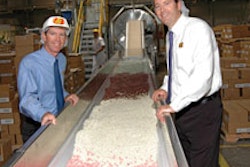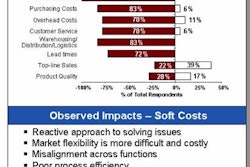Every minute and every dollar counts today. Achieving maximum efficiency is not just a goal; it's a requirement.
In the past, it may have been possible to tolerate certain types of mistakes, but not now. Getting a new distribution center project completed quickly and operating efficiently is a business necessity.
With distribution costs escalating daily, finding more efficient and cost-reducing ways to get products to customers is an absolute must.
A critical component of this process is, of course, the distribution center As these facilities increase in size, some now well over 2 million square feet, any mistakes in planning only escalate the costs, create unnecessary delays and reduce the ultimate operating efficiency of a facility.
Experience suggests that there are five major mistakes in planning a distribution center that, if avoided, can result in a much more satisfactory distribution center project.
Mistake #1. Planning without involving a material handling systems integrator early enough in the process.
Since a distribution center's primary function involves material storage, picking and handling processes and systems, the overall planning for a new facility should include and incorporate these functions from the start.
While this may seem obvious, it doesn't occur as frequently as might be expected. Rather than a deliberate oversight, it often results from focusing on getting the project underway — permitting for the building, obtaining construction bids and starting to show physical evidence the project is underway.
However, there's a major benefit to concurrent planning and careful coordination between the design of the facility and the material handling system requirements. The key is making certain every aspect of the facility is laid out and engineered properly from the start so that all functions integrate seamlessly with the building design and fit like a round peg in a round hole, as opposed to trying to force the proverbial square peg into the round hole. While it can sometimes be done, it's never the right solution.
By not involving the systems integrator with the architect and the contractor in the layout design for the facility, the integrator can often be faced with problems such as insufficient turning radii for lift vehicles, travel aisles that are either too narrow or too wide, building column placement that results in less than optimal layout of pallet racks and space utilization, misplaced power sources, improperly sized roof joists needed to support overhead conveyors, designs that do not account for required mezzanine footers, ceiling heights that are either a hair too low to fit an additional pallet position, or a hair too high such that an additional pallet position could not be accessed by the forklifts. This leaves management suddenly realizing, "We're stuck."
Additionally, another critical element in the design of the building and the material handling equipment inside it is the satisfaction of emergency egress codes. The location of conveyor paths, multi-story pick modules and pallet rack aisles all affect the location of the personnel exit doors. If the design of the material handling system and the building are done independently, then the operational flow of the material inside the building might be sacrificed due to last-minute changes needed to satisfy emergency egress requirements.
One architect points out that the focus is often on the building itself and everything involved with getting into the ground, while the material handling providers may not be called in until after the plans have been approved and the contracts are signed. Once those are out of the way, then the owner's attention moves to material handling considerations.
At that point, the placement of columns, footers, column and joist spans, clear heights and utilities may need to be reengineered to accommodate the material handling equipment, creating undesirable delays and costly change orders. The preferred practice is to have to have the material handling provider onboard at the start of the project, along with the architects.
But it's not just architects. The contractor is also an equally important factor in the overall equation. Cameron Pinzke, vice president of St. Louis, Mo.-based ARCO National Construction Company, has overseen the construction of a substantial number of distribution centers and warehouse facilities. "Having the systems integrator phased into the construction process is a positive move since it only helps in coordinating such tasks as power location, lighting layout and the placement of the fire suppression system," says Pinzke.
"It's also to the owner's advantage because it can be helpful when choosing the overall shape of the building, whether it should be rectangular or square, where the pick area should be and so forth," he adds.
Pinzke says of all the projects he has worked on, only about half of his customers have involved a systems integrator in the earliest stages. And some have paid the penalty. "If a problem arises it could easily delay when they can start shipping product out," Pinzke says. "You might have to start making adjustments to the building, moving power sources, cutting scales into the floor, all of which can be very costly."
This is what Bruce Mills, executive vice president of Thies Distributing, realized after he installed a material handling system in his new Stuart, Fla. facility. "The best thing would have been to bring the integrator on board at the beginning of the planning with the architect and the builder. I could have perhaps also used their input on the shape of the building; maybe a rectangular building would have worked better than a square one in order to maximize the system that was being installed."
Having the integrator involved early can result in improved space utilization and storage efficiencies, which result in productivity and throughput benefits.
Mistake #2. Planning without the proper data and slotting analysis.
Since effective slotting brings improved space utilization, reduced replenishment requirements and increased picking productivity and throughput, slotting should not be overlooked or taken lightly when planning a distribution center.
Operating efficiency and throughput cab be improved by identifying the fastest-moving products and providing for a forward or fast pick area instead of utilizing general storage and picking areas. This allows for an appropriate balance between storage and picking functions and the necessary labor requirements.
Whenever possible, a smaller storage area and larger picking area is preferable, since space is generally cheaper than labor and a smaller storage area/larger picking area promotes fewer stock outs and replenishment. This keeps picking efficiency and throughput up, and labor costs down.
Mistake #3. Planning while ignoring the re-slotting process.
While it's critical to use slotting analysis when considering initial distribution center design, setup and layout, it's just as critical to accommodate re-slotting on a regular basis to adapt to seasonal changes, new products, aging products, promotions, sales events, etc.
Inadequate initial planning results in inefficiencies in the picking and replenishment processes as newer, faster-moving items may not be in the forward picking area or may be stored in an inappropriate storage medium. Meanwhile, products previously considered fast-moving items that are now moving at a much slower rate may be occupying prime pick locations. A new facility can literally become hamstrung due to poor product slotting or the notion that a product slotting analysis is only required for the initial layout and setup of the facility. A very successful facility design, setup and startup may not look so successful over time if the slotting and re-slotting process is ignored.
Mistake #4. Planning without knowing the storage media to be used.
This is a potentially major roadblock to picking efficiencies. While some owners tend to avoid using different types of storage equipment in the process, there are times when it is essential for maximum efficiency.
Placing columns in less than optimal locations can be avoided if the integrator has the opportunity to review the initial plans. Like a soothsayer, an experienced integrator can look into the future. Does the system need to handle goods that arrive on pallets and go out on pallets? Does the system need to handle goods that arrive on pallets and go out in cases? Does the system need to handle goods that arrive on pallets and are picked as eaches? Can similar SKUs be grouped in a smaller area so a picker can make frequent picks with minimal travel? Is it possible to stock and replenish concurrently?
Whether distribution needs call for pallet flow, pallet rack, or carton flow and shelving, it's imperative that the floor design be able to accommodate not only the appropriate storage, but also the workers and equipment.
A project that material handling systems integrator TriFactor worked on for a major beverage distributor in Phoenix, Ariz., illustrates the need for accurate equipment data. "We had to install pallet elevators, which are extremely heavy pieces of machinery," explains Paul Hansen, TriFactor's project manager on the $70 million project. "They require special floor footers, so it was very important that the concrete floor in that area be properly designed and supported. We supplied the information to the customer early in the planning stages. Otherwise, it could have resulted in the floor cracking, which would have been extremely costly to the customer to replace."
Mistake #5. Planning while living with the illusion of thinking that problems can be avoided.
Expecting the unexpected should be a key component of any planning process. By anticipating issues along the way, it is much easier to deal with them should they occur by modifying and adjusting the plans. It is much easier to do this knowing you have a contingency plan, rather than attempting to stay with the original plans, only to discover that the situation could potentially lead to downtime while attempting to make adjustments.
The material handling systems integrator and the distribution center's architect and builder can usually live in harmony, especially if they meet in the early stages of the project.
Still, it's not a "do or die" situation if that doesn't happen. A competent integrator can usually work in the confines of any space, although there can be significant disadvantages. Having to modify an existing facility to try to make it larger or to reconfigure the system to meet the spatial design, can be disruptive and costly, and it often leaves the customer with a system with inherent inefficiencies. With escalating construction costs, it makes good business sense to do it right the first time.
As Thies Distributing's Bruce Mills recalled after he had to make adaptations to the company's Florida facility, "The cost to make the changes wasn't tremendous, but I could have avoided them if I knew at the beginning what I know now."
That's good advice for any company planning to build a new distribution center.
In the past, it may have been possible to tolerate certain types of mistakes, but not now. Getting a new distribution center project completed quickly and operating efficiently is a business necessity.
With distribution costs escalating daily, finding more efficient and cost-reducing ways to get products to customers is an absolute must.
A critical component of this process is, of course, the distribution center As these facilities increase in size, some now well over 2 million square feet, any mistakes in planning only escalate the costs, create unnecessary delays and reduce the ultimate operating efficiency of a facility.
Experience suggests that there are five major mistakes in planning a distribution center that, if avoided, can result in a much more satisfactory distribution center project.
Mistake #1. Planning without involving a material handling systems integrator early enough in the process.
Since a distribution center's primary function involves material storage, picking and handling processes and systems, the overall planning for a new facility should include and incorporate these functions from the start.
While this may seem obvious, it doesn't occur as frequently as might be expected. Rather than a deliberate oversight, it often results from focusing on getting the project underway — permitting for the building, obtaining construction bids and starting to show physical evidence the project is underway.
However, there's a major benefit to concurrent planning and careful coordination between the design of the facility and the material handling system requirements. The key is making certain every aspect of the facility is laid out and engineered properly from the start so that all functions integrate seamlessly with the building design and fit like a round peg in a round hole, as opposed to trying to force the proverbial square peg into the round hole. While it can sometimes be done, it's never the right solution.
By not involving the systems integrator with the architect and the contractor in the layout design for the facility, the integrator can often be faced with problems such as insufficient turning radii for lift vehicles, travel aisles that are either too narrow or too wide, building column placement that results in less than optimal layout of pallet racks and space utilization, misplaced power sources, improperly sized roof joists needed to support overhead conveyors, designs that do not account for required mezzanine footers, ceiling heights that are either a hair too low to fit an additional pallet position, or a hair too high such that an additional pallet position could not be accessed by the forklifts. This leaves management suddenly realizing, "We're stuck."
Additionally, another critical element in the design of the building and the material handling equipment inside it is the satisfaction of emergency egress codes. The location of conveyor paths, multi-story pick modules and pallet rack aisles all affect the location of the personnel exit doors. If the design of the material handling system and the building are done independently, then the operational flow of the material inside the building might be sacrificed due to last-minute changes needed to satisfy emergency egress requirements.
One architect points out that the focus is often on the building itself and everything involved with getting into the ground, while the material handling providers may not be called in until after the plans have been approved and the contracts are signed. Once those are out of the way, then the owner's attention moves to material handling considerations.
At that point, the placement of columns, footers, column and joist spans, clear heights and utilities may need to be reengineered to accommodate the material handling equipment, creating undesirable delays and costly change orders. The preferred practice is to have to have the material handling provider onboard at the start of the project, along with the architects.
But it's not just architects. The contractor is also an equally important factor in the overall equation. Cameron Pinzke, vice president of St. Louis, Mo.-based ARCO National Construction Company, has overseen the construction of a substantial number of distribution centers and warehouse facilities. "Having the systems integrator phased into the construction process is a positive move since it only helps in coordinating such tasks as power location, lighting layout and the placement of the fire suppression system," says Pinzke.
"It's also to the owner's advantage because it can be helpful when choosing the overall shape of the building, whether it should be rectangular or square, where the pick area should be and so forth," he adds.
Pinzke says of all the projects he has worked on, only about half of his customers have involved a systems integrator in the earliest stages. And some have paid the penalty. "If a problem arises it could easily delay when they can start shipping product out," Pinzke says. "You might have to start making adjustments to the building, moving power sources, cutting scales into the floor, all of which can be very costly."
This is what Bruce Mills, executive vice president of Thies Distributing, realized after he installed a material handling system in his new Stuart, Fla. facility. "The best thing would have been to bring the integrator on board at the beginning of the planning with the architect and the builder. I could have perhaps also used their input on the shape of the building; maybe a rectangular building would have worked better than a square one in order to maximize the system that was being installed."
Having the integrator involved early can result in improved space utilization and storage efficiencies, which result in productivity and throughput benefits.
Mistake #2. Planning without the proper data and slotting analysis.
Since effective slotting brings improved space utilization, reduced replenishment requirements and increased picking productivity and throughput, slotting should not be overlooked or taken lightly when planning a distribution center.
Operating efficiency and throughput cab be improved by identifying the fastest-moving products and providing for a forward or fast pick area instead of utilizing general storage and picking areas. This allows for an appropriate balance between storage and picking functions and the necessary labor requirements.
Whenever possible, a smaller storage area and larger picking area is preferable, since space is generally cheaper than labor and a smaller storage area/larger picking area promotes fewer stock outs and replenishment. This keeps picking efficiency and throughput up, and labor costs down.
Mistake #3. Planning while ignoring the re-slotting process.
While it's critical to use slotting analysis when considering initial distribution center design, setup and layout, it's just as critical to accommodate re-slotting on a regular basis to adapt to seasonal changes, new products, aging products, promotions, sales events, etc.
Inadequate initial planning results in inefficiencies in the picking and replenishment processes as newer, faster-moving items may not be in the forward picking area or may be stored in an inappropriate storage medium. Meanwhile, products previously considered fast-moving items that are now moving at a much slower rate may be occupying prime pick locations. A new facility can literally become hamstrung due to poor product slotting or the notion that a product slotting analysis is only required for the initial layout and setup of the facility. A very successful facility design, setup and startup may not look so successful over time if the slotting and re-slotting process is ignored.
Mistake #4. Planning without knowing the storage media to be used.
This is a potentially major roadblock to picking efficiencies. While some owners tend to avoid using different types of storage equipment in the process, there are times when it is essential for maximum efficiency.
Placing columns in less than optimal locations can be avoided if the integrator has the opportunity to review the initial plans. Like a soothsayer, an experienced integrator can look into the future. Does the system need to handle goods that arrive on pallets and go out on pallets? Does the system need to handle goods that arrive on pallets and go out in cases? Does the system need to handle goods that arrive on pallets and are picked as eaches? Can similar SKUs be grouped in a smaller area so a picker can make frequent picks with minimal travel? Is it possible to stock and replenish concurrently?
Whether distribution needs call for pallet flow, pallet rack, or carton flow and shelving, it's imperative that the floor design be able to accommodate not only the appropriate storage, but also the workers and equipment.
A project that material handling systems integrator TriFactor worked on for a major beverage distributor in Phoenix, Ariz., illustrates the need for accurate equipment data. "We had to install pallet elevators, which are extremely heavy pieces of machinery," explains Paul Hansen, TriFactor's project manager on the $70 million project. "They require special floor footers, so it was very important that the concrete floor in that area be properly designed and supported. We supplied the information to the customer early in the planning stages. Otherwise, it could have resulted in the floor cracking, which would have been extremely costly to the customer to replace."
Mistake #5. Planning while living with the illusion of thinking that problems can be avoided.
Expecting the unexpected should be a key component of any planning process. By anticipating issues along the way, it is much easier to deal with them should they occur by modifying and adjusting the plans. It is much easier to do this knowing you have a contingency plan, rather than attempting to stay with the original plans, only to discover that the situation could potentially lead to downtime while attempting to make adjustments.
The material handling systems integrator and the distribution center's architect and builder can usually live in harmony, especially if they meet in the early stages of the project.
Still, it's not a "do or die" situation if that doesn't happen. A competent integrator can usually work in the confines of any space, although there can be significant disadvantages. Having to modify an existing facility to try to make it larger or to reconfigure the system to meet the spatial design, can be disruptive and costly, and it often leaves the customer with a system with inherent inefficiencies. With escalating construction costs, it makes good business sense to do it right the first time.
As Thies Distributing's Bruce Mills recalled after he had to make adaptations to the company's Florida facility, "The cost to make the changes wasn't tremendous, but I could have avoided them if I knew at the beginning what I know now."
That's good advice for any company planning to build a new distribution center.



















